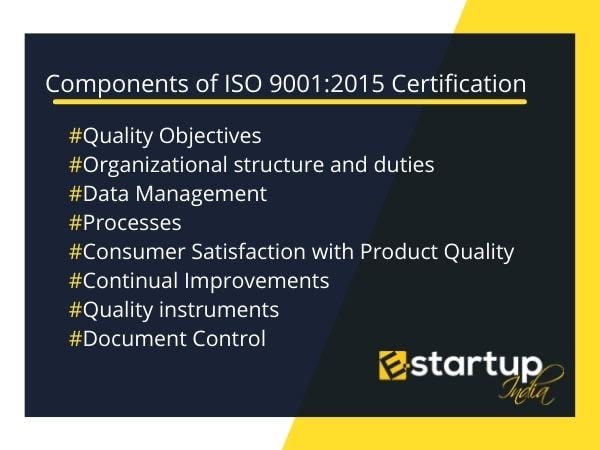As we know Quality Management System (QMS) is the determination for ISO 9001:2015 Standard. The blooming implementation of a QMS can help your organization to achieve business excellence. In this article, we will discuss on Components of ISO 9001 Certification.
What is a Quality Management System?
The Quality Management System may be a centralized system that stimulates management review, beneficial resource utilization, and continuous improvements. It standardizes business methods that are implemented to make sure organizations are following a consistent procedure in production and operation. Also, ISO 9001 Certification ensures continuous improvement and enhanced risk assessment. It assists in achieving a systemic approach, product quality, and process density across all offices of the organization.
Why ISO for 9001 Certification
ISO 9001 certification is a universally accomplished quality management standard, utilised by institutions all over the world to standardize and improve the service given to consumers. The standard has used across all districts of the industry but is more common in some than others. Also, it helps in several objectives –
- Enormous stress on the responsibility of top-level management.
- Adequate evaluation of intimidations & opportunities in a systematic and farsighted way.
- Use of modest but comprehensive that covers various administration systems
- A more productive method for higher quality management.

Components of ISO 9001 Certification
ISO 9001:2015 is based on the ensuing principles of Quality Management:
1 Quality Objectives
QMS requires drafting the standard objectives, to begin with. The objectives will define the future goals and accordingly the purpose of QMS. Also, It assists the organization to understand customer requirements and cater to the growing demand effectively.
2 Organizational structure and duties
QMS must have the updated managerial structure and include the corresponding responsibilities to obtain goals and set KPIs for every team.
3 Data Management
Managing the administrative data effectively is a key provision for the QMS system. Data Management assists in identifying the vulnerabilities and taking the required corrective activities promptly.
4 Processes
process optimizations maintain the below steps:
• Identifying the managerial processes and resources utilized
• Defining method standards and corrective actions if any
• Setting up a way to estimate continuous improvements
• Recording the modifications in process, improvements, and results. Follow a uniform approach to realize a constant result.
5 Consumer Satisfaction with Product Quality
Assessing Customer Satisfaction is another requirement of the QMS. Customer Satisfaction is the measure of quality process effectiveness.
6 Continual Improvements
Continuous Development is a must-do practise to follow for achieving consistent product quality.
7 Quality instruments
For product companies that utilize ISO 9001:2015 to enhance their efficiency and service quality, the instruments wielded must be maintained to a high grade of quality.
8 Document Control
QMS should comprise documented information that records all important aspects and organizational operations comprising the following:
• Employee Communication on critical projects or tasks
• Evidence of Process Improvements, Operational Processes, Organizational Structure, etc.
• QMS Conformity and Knowledge Sharing.
you require any guidance as regards the ISO certification In India please feel free to contact our business advisors at 8881-069-069.
Download E-Startup Mobile App and never miss the most-fresh updates associating to your business.
The information which is given is informative thanks for posting such type of article. here are some more information about iso 9001 certification